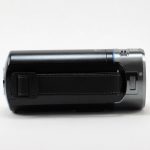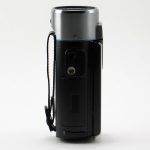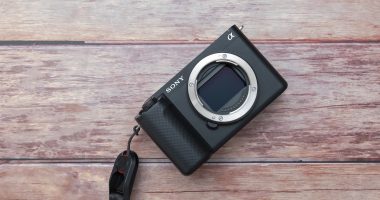I’m going to start this post off by stating that I have not used a camcorder of any type in over 10 years. Back then, camcorders were huge, bulky machines that yes, became much smaller, but were still quite large thanks in part to having to use fairly large magnetic tape media. In fact, the last camcorder I ever used was a Sony unit that required use of Sony’s Hi8 format. These days, camcorders are all digital and most use tiny SDHC cards that can hold hours of footage. This is great except for one problem. Digital cameras these days can usually serve a secondary function and replace the camcorder for most video taking situations. There is a limit however to the length of video you can take on a digital camera which means that for anything much longer than 30 minutes, a digital camcorder still has its place in the world. A pure digital camcorder is somewhat out of my comfort level as it’s not something I thought I’d ever need, but I decided to give the Samsung HMX-QF20 a shot and see if something like this still had it’s place in my bag of gear.
Design
 The Samsung HMX-QF20 is a tiny digital camcorder that feels like you’re holding something like a Red Bull in your hand, but not as tall. A few of its more notable features include full 1920×1080 HD recording, 20x optical zoom/40x digital, still image capture at 5.1mp, and the ability to share video wirelessly to other devices and social networks directly. It also features a 2.7-inch touch screen and can be twisted and used either left or right handed.
The Samsung HMX-QF20 is a tiny digital camcorder that feels like you’re holding something like a Red Bull in your hand, but not as tall. A few of its more notable features include full 1920×1080 HD recording, 20x optical zoom/40x digital, still image capture at 5.1mp, and the ability to share video wirelessly to other devices and social networks directly. It also features a 2.7-inch touch screen and can be twisted and used either left or right handed.
Because Samsung chose to make many of the features available through the touch screen, you’ll find that the HMX-QF20 has very little buttons. It only has a 4 way directional pad on the rear of the camera and a large record button at its center. Above that, you’ll find a the DC IN port covered by a plastic door. Aside from that, the camera is very minimal making it very simple to use and operate. No complicated button operations, no excess, and no need to fumble around.
Overall, it’s a very nice design. Simple. It feels great in your hands and the sizing feels just right – not too small and not too large. The strap used on the HMX-QF20 isn’t padded, but its of a nice leather type material that looks good and don’t cut into the back of your hands. It can be easily sized and even if you don’t use the strap, the camera can still be held comfortably. I like the fact that the camera does not use a lens cap and instead has one built in that can cover or uncover the lens with a flip of a switch. It’s also really nice to see that Samsung chose to use the higher end Schneider Kreuznach lens with the HMX-QF20 as well.
Usage
 To start using the HMX-QF20, just flip out the screen. The camera will automatically turn itself on and you can start recording. To turn it off, just flip the screen back into the closed position and it will turn itself off. Again. Simple. It’s not very complicated to use at all, but you will need to learn how to get around it a bit. Luckily that takes very little time since the HMX-QF20 tried to keep things as simple as possible.
To start using the HMX-QF20, just flip out the screen. The camera will automatically turn itself on and you can start recording. To turn it off, just flip the screen back into the closed position and it will turn itself off. Again. Simple. It’s not very complicated to use at all, but you will need to learn how to get around it a bit. Luckily that takes very little time since the HMX-QF20 tried to keep things as simple as possible.
After turning the camera on, just point it and press the very large red record button on the rear. That’s it. Zooming in and zooming out is also quite easy by using the 4-way directional buttons. The one on the left is to zoom out and the one on the right is to zoom in. The HMX-QF20 zooms in fairly quickly too, a little too quickly. It’s hard gauging how far in or out you’ll zoom with the buttons as it can zoom in and out really quickly and most of the time, you’ll end up over shooting your mark. It would have been nice if it would have maybe stopped at each increment or just slowed down the rate a bit. You can however sold this bit by using the touchscreen instead and zoom using that which gives much more control over it. If you don’t want to mess with any of the settings, this is all you’ll ever really need to do to use the HMX-QF20. Most users however may want to use the other features offered by the camera.
The HMX-QF20 also functions as a regular point and shoot camera. Just switch it into camera mode and you can use the record button as a shutter release. However, the camera only shoots still at 5mp which in this day and age, is a bit low, even when compared to camera phones which can be much higher now. The still shows are still pretty decent, but you’ll want to use a much better point-and-shoot camera if you plan on shooting a lot of still photos.
Back to using the HMX-QF20, besides the controls on the rear, you’ll be using the touchscreen quite a bit. It is much simplified over the standard Samsung user interfaces I’ve come to know. There is an actual “home” button on the side of the screen that you use to return to the main menu. There aren’t too many advanced settings for the camcorder itself but you can use the menus to access features like the art filters and the WiFi sharing options. What is a bit annoying however and I wish Samsung would have done this is link the 4-way directional buttons on the rear with the menu system. I kept wanting to use the buttons to move my selection around on the menu, but that didn’t work at all. I had to use my finger and tap my selection or use my finger to drag the menu up and down. I like touch screens, but not for navigating around the menus.
Final Thoughts
 For an easy to use camcorder, the Samsung HMX-QF20 is not bad at all. It’s small, handy, and can be turned on at a moments notice since the on/off is linked to the screen. The buttons are large and easy to use and for the most part, you won’t really need to use the touchscreen all that much unless you want to access a few of the more advanced settings. As a camcorder, it’s fun to use and very light. As a still camera however, I would not use it for this. Yes, it’s great that it does include this function for quick shots if you don’t happen to have a better camera on you, but for the most part, I’d use the HMX-QF20 strictly as a camcorder to record video.
For an easy to use camcorder, the Samsung HMX-QF20 is not bad at all. It’s small, handy, and can be turned on at a moments notice since the on/off is linked to the screen. The buttons are large and easy to use and for the most part, you won’t really need to use the touchscreen all that much unless you want to access a few of the more advanced settings. As a camcorder, it’s fun to use and very light. As a still camera however, I would not use it for this. Yes, it’s great that it does include this function for quick shots if you don’t happen to have a better camera on you, but for the most part, I’d use the HMX-QF20 strictly as a camcorder to record video.
I like the fact that the HMX-QF20 features the much better Schneider Kreuznach lens and has a true, 20x optical zoom and a super fast, f/1.8 aperture for good low-light performance. I also appreciate the switch grip function that allows for either left or right hand usage which is something you normally aren’t able to do with regular cameras.
Overall, a great, inexpensive camcorder that is light, versatile, and takes excellent HD video that should make most consumers happy.
Shop Link
- Samsung HMX-QF20 – Samsung HMX-QF20 HD Digital Video Camcorder













